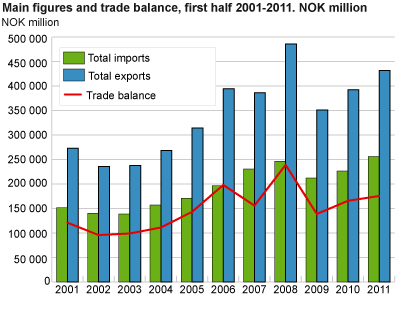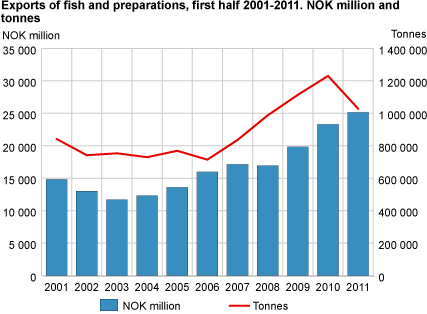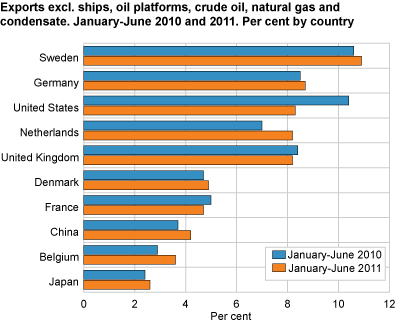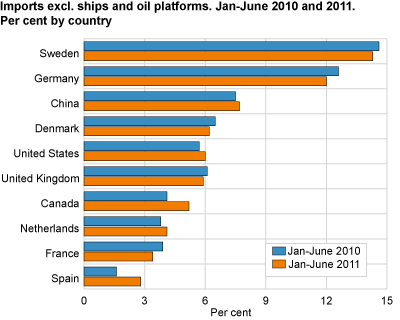Content
Published:
This is an archived release.
High trade surplus
Exports of goods came to NOK 65.2 billion in June 2011, and imports to NOK 40.4 billion. The Norwegian trade surplus was NOK 24.7 billion; an increase of 4.3 per cent compared with June last year.
Reference is also made to the article describing the first half of 2011. |
In June 2011, the exports of goods amounted to NOK 65.2 billion, compared with NOK 66.1 billion June last year; a decrease of 1.5 per cent. The imports of goods came to NOK 40.4 billion; a decrease of 4.7 per cent compared with last year.
Compared with January to April this year, the trade surpluses in May and June have been relatively low, partly due to a reduced exports volume caused by maintenance work at the continental shelf.
Reduced export volume from the continental shelf
In June, the total export value of crude oil, natural gas and condensates came to NOK 35 billion; a decrease of NOK 1.4 billion compared with June last year, or 3.9 per cent. The amount of barrels exported in June ended at 38 million, compared to 49 million barrels in June 2010. Still, the export value was rising due to considerably higher prices in June 2011 than in June 2010. The crude oil price averaged NOK 634 per barrel, compared with NOK 483 per barrel in June last year. The export volume of natural gas came to 6.1 billion standard cubic metres; a decrease of 1.6 billion compared to last year.
| January-June | Change in per cent | June | Change in per cent | ||||||||||||||||||||||||||||||||||||||||||||||||||||||||||||||||||||||||||||
|---|---|---|---|---|---|---|---|---|---|---|---|---|---|---|---|---|---|---|---|---|---|---|---|---|---|---|---|---|---|---|---|---|---|---|---|---|---|---|---|---|---|---|---|---|---|---|---|---|---|---|---|---|---|---|---|---|---|---|---|---|---|---|---|---|---|---|---|---|---|---|---|---|---|---|---|---|---|---|---|
| 2010 | 2011 | 2010 | 2011 | ||||||||||||||||||||||||||||||||||||||||||||||||||||||||||||||||||||||||||||
| 1 Imports | 217 296 | 244 227 | 12,4 | 42 435 | 40 441 | -4,7 | |||||||||||||||||||||||||||||||||||||||||||||||||||||||||||||||||||||||||
| 2 Exports | 387 312 | 429 643 | 10.9 | 66 146 | 65 183 | -1.5 | |||||||||||||||||||||||||||||||||||||||||||||||||||||||||||||||||||||||||
| Of which | |||||||||||||||||||||||||||||||||||||||||||||||||||||||||||||||||||||||||||||||
| Crude oil | 137 561 | 163 095 | 18.6 | 23 648 | 24 163 | 2.2 | |||||||||||||||||||||||||||||||||||||||||||||||||||||||||||||||||||||||||
| Natural gas | 84 245 | 82 638 | -1.9 | 12 254 | 10 453 | -14.7 | |||||||||||||||||||||||||||||||||||||||||||||||||||||||||||||||||||||||||
| Condensates | 2 731 | 4 148 | 51.9 | 488 | 364 | -25.4 | |||||||||||||||||||||||||||||||||||||||||||||||||||||||||||||||||||||||||
| 3 Exports excl. crude oil, natural gas and condensates | 162 774 | 179 762 | 10.4 | 29 756 | 30 202 | 1.5 | |||||||||||||||||||||||||||||||||||||||||||||||||||||||||||||||||||||||||
| 4 Trade balance (2-1) | 170 016 | 185 416 | 9.1 | 23 711 | 24 742 | 4.3 | |||||||||||||||||||||||||||||||||||||||||||||||||||||||||||||||||||||||||
| 5 Trade balance excl. oil, natural gas and condensates (3-1) | -54 522 | -64 465 | . | -12 679 | -10 239 | . | |||||||||||||||||||||||||||||||||||||||||||||||||||||||||||||||||||||||||
Increase in exports of refined mineral products
The export value of goods excluding ships, oil platforms, crude oil, condensates and natural gas was NOK 30.2 billion in June, compared with NOK 29.8 billion in June last year; an increase of 1.5 per cent.
This development was mainly due to an increase in export value of refined mineral products of NOK 1.6 billion, or 56.3 per cent. The total export this year for refined mineral products was NOK 25.6 billion; an increase of 40.2 per cent compared with the same period last year.
The export value of machinery and transport equipment decreased NOK by 1.1 billon, or 16.5 per cent. The commodity groups ‘general industrial machinery’ and ‘machinery specialized for particular industries’ both decreased by nearly NOK 500 million, or 29.9 and 35.6 per cent respectively. On the contrary, electrical machinery, apparatus and appliances showed an increase of nearly NOK 500 million.
The export value of fish fell by NOK 400 million, or 10 per cent, compared to June last year.
Decrease in imports of machinery and transport equipment
In June, imports of goods excluding ships and oil platforms amounted to NOK 40.4 billion, compared with NOK 42.4 billion in June last year, a decrease of 4.7 per cent.
Machinery and transport equipment showed a decline of NOK 726 million, or 4.7 per cent, mainly due to a decrease in road vehicles of NOK 578 million. The commodity groups electrical machinery and power generating machinery decreased by NOK 168 and 164 million respectively. However, machinery specialized for particular industries showed an increase of NOK 218 million.
Tables:
- Table 1 Imports of commodities, ships and oil platforms excluded. June and January-June 2010 and 2011. NOK million
- Table 2 Exports of commodities, ships and oil platforms excluded. June and January-June 2010 and 2011 Preliminary figures. NOK million
- Table 3 Trade with countries and regional groups of countries. January-June 2010 and 2011. Preliminary figures. NOK million
Increased trade with abroadOpen and readClose
Total exports for the first half of 2011 came to NOK 429.6 billion, while imports amounted to NOK 244.2 billion. The trade surplus thus ended at NOK 185.4 billion, up 15.4 per cent compared to the same period in 2010.
The trade balance for the first half-year of 2011 was strengthened by 9.1 per cent compared to 2010. The surplus resulted from a value increase in crude oil exports. Furthermore, both imports and mainland exports grew, by 12.4 and 10.4 per cent respectively.
Increased oil price, reduced production
Crude oil export values grew by 18.6 per cent, from NOK 137.6 billion for the first six months of 2010, to NOK 163.1 billion so far this year. The increase of NOK 25.5 billion was mainly due to rising oil prices – up from an average of NOK 471 to NOK 629 per barrel comparing the two time periods. At the same time, production fell, reducing the number of barrels exported by 32.6 million, to a total of 259.4 million barrels exported in the first half-year of 2011.
Minor decrease in natural gas exports
From January-June 2010 to 2011, total export values of natural gas fell by NOK 1.6 billion, just under two per cent, ending at NOK 82.6 billion. The decrease was caused by lower export volumes, as exports so far this year amounted to only 46.9 billion standard cubic metres (Sm3) of natural gas, compared to 52.3 billion last year.
Increasing commodity exports
So far this year, we have exported goods excluding ships, oil platforms, crude oil, natural gas and condensates corresponding to a value of NOK 179.8 billion – up 10.4 per cent.
All main commodity groups except machinery and transport equipment grew in the first six months this year compared to 2010. The groups with the largest absolute increases were mineral fuels, manufactured goods and chemicals.
Refined mineral products increased by NOK 7.3 billion, just above 40 per cent higher than last year’s value. Total export values so far this year reached NOK 25.6 billion.
The commodity group manufactured goods had a 10.2 per cent higher value in the first half of 2011 than in 2010. The increase consisted of NOK 3.7 billion, making the group’s total export NOK 40 billion. A 15 per cent increase for non-ferrous metals drove the value up. Both metal prices and commodity demand have generally been higher this year than last.
Record high fish exports
High salmon prices combined with volume growth led to record exports of fish compared to the corresponding half year periods throughout time. So far this year we have exported fish for NOK 25.1 billion, up NOK 1.8 billion, or 7.9 per cent, compared with the first half of 2010.
The salmon prices hit an all time high in April, when the average monthly price came to NOK 42.73 per kilo of fresh whole salmon. Subsequently, prices have dropped and are currently at NOK 32.73 per kilo for the month of June. Strong growth in consumer demand paired with reduced production in Chile have been the main drivers of the higher prices this year.
Comparing the first six months of 2010 and 2011, France has surpassed Russia as the country with the highest import value for fish from Norway. With growth nearing 10 per cent, France has imported fish for the sum of NOK 2.6 billion so far this year. Russia still imports the greatest volume of fish, with a total of 144 thousand tonnes in the time period. However, this was 51 thousand tonnes lower than the first half-year period of 2010. Ranked third by value is Denmark, at NOK 1.9 billion, followed by Poland with fish imports for NOK 1.8 billion.
Strengthened import, particularly for cars
Imports of goods excluding ships and oil platforms amounted to NOK 244.2 billion in the first half of 2011, up from NOK 217.3 billion the same time last year. The NOK 26.9 billion increase was akin to an improvement of 12.4 per cent. Some of the upturn could be due to globally high prices for raw materials, both for foodstuffs and industry inputs.
All main commodity groups grew in January–June 2011. The greatest increases were found in the groups machines and transport equipment, manufactured goods and crude materials.
Machines and transport equipment rose by NOK 7.6 billion, equivalent of 9.6 per cent. Road vehicles contributed the most, ending at NOK 23.7 billion for the first half of 2011, up almost 10 per cent from last year. The increase from 2009 was nonetheless more drastic, as 2011 figures were almost 50 per cent higher than the first half of 2009, when values reached a low point at NOK 16.1 billion. So far this year the passenger car import rose by NOK 1.3 billion, amounting to a total of NOK 13.9 billion.
Greatest trade increase to OECD countries
OECD and EU countries are our main trading partners. The majority of our trade, around 70 per cent, is sent to Europe, where Sweden ranks as number one for both commodity flows. In contrast, we have little trade with Africa, South America and Oceania - these together account for only four per cent of total imports and exports.
Trade with all important trade areas has gone up. The largest increase from the first half-year of 2010 was seen with regard to OECD countries, with growth of NOK 22.4 billion for imports and NOK 14.3 billion for exports. As usual, Europe improved the most; imports were 10.8 per cent higher, while exports grew by 16.9 per cent. At the continent level, export values to Asia, North America and South America and import values to Oceania decreased.
Asian trade increased by 10.7 per cent for imports, while exports fell by 3.8 per cent. Trade with China, our largest Asian partner, kept the import values high and also lessened the fall for exports. Imports from China increased by 16.3 per cent, to a total of NOK 18.9 billion. At the same time, corresponding exports rose by 27.4 per cent, adding up to NOK 7.6 billion. Nevertheless, decline in trade with South Korea, Malaysia and Singapore kept the total export values to Asia in the negative.
Contact
-
Information services external trade
E-mail: utenrikshandel@ssb.no
-
Nina Rolsdorph
E-mail: nina.rolsdorph@ssb.no
tel.: (+47) 41 51 63 78
-
Jan Olav Rørhus
E-mail: jan.rorhus@ssb.no
tel.: (+47) 40 33 92 37




